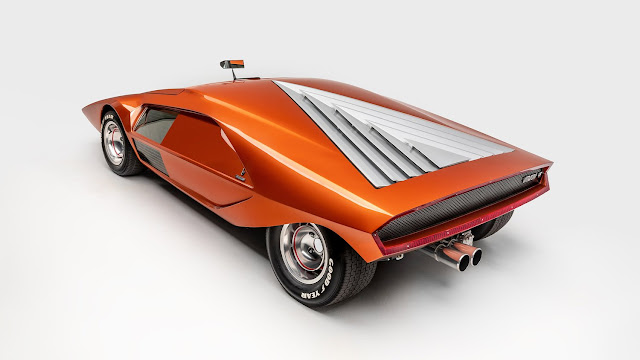... die Fronthaube (Vordach) öffnet nach vorne, die mit Lamellen versehene dreieckige Motorhaube geht zur Seite auf ...
Dedicated to our english readers
This concept car owned by Philip Sarofim won the Wedge-Shaped Concept Cars & Prototypes Early class at the Concours during Pebble Beach Week 2024. It underwent a full restoration in 2000 to return it to its original bronze color.
The 1970 Lancia Stratos HF Zero prototype is an Italian design icon that previewed one of the best-loved racing cars ever, the Lancia Stratos HF. It featured primary shapes, radical geometries, and round taillights—some hallmarks that form part of Lancia’s design history. Unveiled at the 1970 Turin Motor Show, built by Nuccio Bertone, and based on a design by Marcello Gandini, the prototype was a fully functional vehicle and just 85 cm (33.5 in) tall.
The car’s windshield extends upwards, providing an outstanding view out of the front and top. The lights were innovative, with a front row of 55-W bulbs and a rear strip of 84 small bulbs. The interior was revolutionary, with practically horizontal seats and an instrument panel shifted to the left and embellished with a green acrylic glass display.
The 115-hp 1.6-L V4 engine (two twin-barrel Solex carburetors from a Lancia Fulvia HF) and the central dual-tailpipe exhaust system highlight the prototype’s sporty spirit on which the Lancia Stratos would later be based for its road and racing versions.
In 1971 the Lancia Stratos made its debut with a futuristic wedge shape and the V6 engine from the Dino 246 Ferrari. The front end was sharp, and the sloping windshield encompassed the front pillar and continued into the side windows. The roof dropped vertically over the small rear window, enveloped by the large bonnet. Round taillights and an assertive wing stood out at the rear.
When Nuccio Bertone, the prototype’s “father,” saw the final version of the Lancia Stratos, he said, “it fits the driver and navigator like their kit does an athlete, showing off their muscles.”
The car was designed for rallying, starting from the bonnet and trunk consisting of two lightweight shells, including their respective fenders, with a wide opening for quick action during races. Inside were two seats and only two compartments for racing helmets—even in the road version. The interior used “color blocking” to create design contrasts using primary colors.
The Lancia Stratos HF Group 4 won the Monte Carlo Rally three times in a row, two Constructors’ World titles (1975 and 1976), and two European Drivers’ titles, as well as Sandro Munari’s victory in the 1977 FIA Cup for Rally Drivers. From the 1975 racing season, it was kitted out in the white and green colors of its sponsor Alitalia for one of the most memorable liveries in motorsport.
More details here: www.petersen.org
Tipps zur Blog-Nutzung
Alles rund um unsere Mobilität: Autos, Bikes, Räder, Auto-Reisen,
https://mobilitaet-heute.blogspot.com
Einfache Themensuche
1. oben im Blog mit der Lupe
(Suchwort eingeben, alles dazu wird gezeigt)
2. Kästen am Textende anklicken
Interessantes senden an:
achim.stahn@interpress-ipr.de














Kommentare
Kommentar veröffentlichen